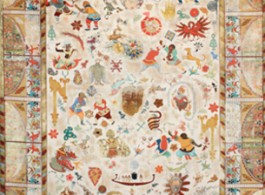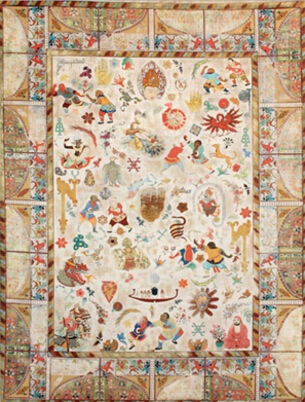Hong Kong (6 July 2016) — Pearl Lam Galleries is delighted to present Labyrinth(s), featuring works by eight contemporary artists: Leonardo Drew, Golnaz Fathi, Gonkar Gyatso, Ni Haifeng, Peter Peri, Kour Pour, Gatot Pujiarto, and Ben Quilty. The title of the exhibition references Jorge Luis Borges’s celebrated short story “The Garden of Forking Paths”.
In Borges’ story, the protagonist Dr. Yu Tsun muses about a lost labyrinth:
I imagined it inviolate and perfect at the secret crest of a mountain; I imagined it erased by rice fields or beneath the water; I imagined it infinite, no longer composed of octagonal kiosks and returning paths, but of rivers and provinces and kingdoms…I thought of a labyrinth of labyrinths, of one sinuous spreading labyrinth that would encompass the past and the future and in some way involve the stars. Absorbed in these illusory images, I forgot my destiny of one pursued.
By investigating the associative potential of their chosen media and forming metaphorical labyrinths with diverse artistic languages that offer unlimited alternatives, the artists in this exhibition examine the notion of infiniteness. The use of different media in turn constructs a huge labyrinth. Audiences can decide for themselves what the artworks really are: paintings, sculptures, photographs, installations, or hybrid fusions. Meanwhile, different artists build up the labyrinth into different universes in specific gradations. They investigate the inner labyrinths of materials, connections between figuration and abstraction, politics of identity, religion, and pop-culture, and indulge the viewers in a visual sublime.
With the exploration of René Guénon’s explanation of Eastern and Western traditions, British artist Peter Peri (b. 1971) shifts the complex representations of humans and heaven into symbols and the use of lines as informed by Taoist thinking in his marker pen and spray paint on linen works.
The woodblock pieces by 29-year-old Los Angeles-based British-Iranian artist Kour Pour (b. 1987) are informed by Western abstract tradition and Japanese aesthetics. They are actually a translation of earthquake and volcano maps produced by the Japanese Geological Survey, referring to the shifting and overlapping of different aesthetics with this physical metaphor of transformation. Celebrating the craftsmanship of carpets in different cultures, where decorative motifs trace back cultural histories, Shaolin Mural (Fragments), a piece from Pour’s carpet painting series, consists of different cultural patterns such as the Chinese Buddha and decorations, Persian horses, Egyptian gods and figures, as well as Japanese characters.
Interested in post-colonialism and cultural exchange, Chinese artist Ni Haifeng (b. 1964) makes written marks on top of bodies, objects, and environments. Ni states his intention, “The self is examined at various specific temporal/spatial coordinates and can therefore be seen as a cue to the broader historical realities.” The Warehouse (1988) is a series of photographs from the late 1980s that conveys our desire to project personal memories onto a physical origin that is always subject to change. Ni’s photograph Self-Portrait as Part of the Porcelain Export History (1999–2001) addresses the way in which colonial history has infringed onto our bodies in the name of otherness, an issue central to the discussion of identity politics during the 1990s.
Influenced by abstract expressionism, American artist Leonardo Drew’s (b. 1961) work places an emphasis on concept, materiality, and process. He asserts the physical characteristic of his materials, emphasising their texture, colour, and shape, to create something that is insistently sculptural. The connectivity between humanity and the physical existences is projected from his wooden lines and paper, giving his artwork lives of their own.
Emphasising an infinite series of lines—a growing, dizzying net of divergent, convergent, and parallel lines—Iranian artist Golnaz Fathi’s (b. 1972) works are influenced by traditional Persian calligraphy, but are entirely modern. She practices drawing the lines on paper every day until the paper is covered with black ink. Despite the fact that writing is a significant element in her works, Fathi does not aim to present the existing aesthetic value and form of traditional calligraphy, but instead unites these values and forms with images that can be appreciated in the contemporary world.
The artworks by Gonkar Gyatso, Gatot Pujiarto, and Ben Quilty contain subtle iconography and symbolism. Quilty’s investigations surround the issue of masculinity. His works relate to his own past, as well as Australia’s wider historical culture. The Photojournalist (AQ) (2014) is a portrait of Quilty’s cousin, photojournalist Andrew Quilty, who spends his time displaced in countries like Syria and Afghanistan. The work refers to the relationship between identity and current affairs. Gonkar Gyatso’s Buddha sculptures are covered with stickers that reference pop culture, indicating how cultural globalisation has affected traditional Buddhism. The works can be seen as the artist’s own meditation on what it means to be living in a particular place at a particular time. Gyatso inserts Buddhist and Tibetan iconography into our daily lives. Gatot Pujiarto’s works are narrative and figurative. The works are influenced by his daily experiences and surrounding occurrences, and they preserve his memories.




